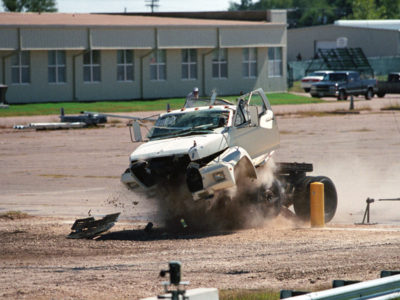 Despite a worldwide pandemic that shut down businesses and kept most workers at home through the spring and much of the summer, 37 Texas A&M Transportation Institute (TTI) researchers, technicians and support staff in the Roadside Safety and Physical Security Division have been working nonstop conducting a near-record number of crash tests for clients across the country.
Despite a worldwide pandemic that shut down businesses and kept most workers at home through the spring and much of the summer, 37 Texas A&M Transportation Institute (TTI) researchers, technicians and support staff in the Roadside Safety and Physical Security Division have been working nonstop conducting a near-record number of crash tests for clients across the country.
“Typically, we complete 50 to 60 crash tests each fiscal year here at the RELLIS Campus,” explains Senior Research Engineer Lance Bullard, who leads the division. “Our fiscal year ends Aug. 31, and by that date we’d conducted 112 full-scale crash tests.”
Why twice as much work?
The Texas Department of Transportation and other state DOTs across the country are on a fast-track to have all their roadway safety hardware (like barriers, guardrails and crash cushions) meet the new crash-performance standards set by the federal government. The new standards were adopted in 2016.
“The Manual for Assessing Safety Hardware, or MASH, was changed, among other things, in order to reflect the nation’s changing vehicle fleet,” Bullard points out. “Vehicles have gotten taller and heavier, so that by itself means the safety equipment could react differently in a crash. We all need to make sure we are as safe as possible on our roadways.”
Bullard says another reason for the increased work is the development of a pooled-fund program. Twenty-eight states and a Canadian province decided to work together and pool their research dollars so that TTI can help them design, develop and crash test safety hardware they will share. Those states then can use the same type of MASH compliant hardware on their roads and highways.
Considering the Proving Grounds’ volume of work since 1990, fiscal year 2020 will be in history books as the second busiest year for crash tests at TTI. The busiest (by four tests) was in 1995. In the last three decades, only five years have seen more than 100 crash tests. And in 2017, for example, there were 55 tests.
In addition to helping states meet the latest MASH standards, new and innovative roadside safety devices are also being developed and tested.
In two such examples, TxDOT is working with TTI engineers to design a fence system that attaches to the top of a concrete barrier so that motorcycle riders don’t go over the barrier and suffer more severe injuries during a crash. Also, testing is under way with manufacturers of storefront bollards to determine if their products can successfully keep vehicles from crashing through storefronts and restaurant windows.
“Yes, we have been busy, with no letup in sight,” Bullard says. “We are booked solid through February of 2021. But there is plenty of job satisfaction. Everything we do here is designed for just one thing: saving lives.”